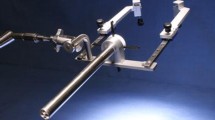Abstract
Trocars used in laparoscopic surgery occasionally produce serious complications, such as bleeding, visceral injury, or incisional hernia. We report the evaluation of a new, potentially safer laparoscopic access device in which the cutting obturator of a standard trocar is replaced by a blunt, radially expanding device. Conventional and radially expanding trocars were used in laparoscopic cholecystectomies in 12 pigs. Their abdominal walls were excised and the defects caused by the trocars were examined. The defects caused by the radially expanding devices were about 50% narrower (P<0.001), and the incidence of abdominal wall bleeding was considerably less (0% vs 21%) with the radially expanding trocars. Since incisional hernias at trocar sites are related to the size of the abdominal wall defect, the use of radially expanding trocars should decrease the incidence of this complication. There should also be less risk of visceral injury.
Similar content being viewed by others
References
Apelgren KN, Scheeres DE (1994) Aortic injury. A catastrophic complication of laparoscopic cholecystectomy. Surg Endosc 8: 689–691
Baadsgaard SE, Bille S, Egelblad K (1989) Major vascular injury during gynecologic laparoscopy. Acta Obstet Gynecol Scand 68: 283–285
Hurd WW, Pearl ML, DeLancey JO, Quint EH, Garnett B, Bude RO (1993) Laparoscopic injury of abdominal wall blood vessels: a report of three cases. Obstet Gynecol 82(4 Pt 2 suppl): 673–676
Kaali SG, Barad DH (1992) Incidence of bowel injury due to dense adhesions at the site of direct trocar insertion. J Reprod Med 37(7): 617–618
Kadar N, Reich H, Liu CY, Manko GF, Gimpleson R (1993) Incisional hernias after major laparoscopic gynecologic procedures. Am J Obstet Gynecol 168: 1493–1495
Kurtz BR, Daniell JF, Spaw AT (1993) Incarcerated incisional hernia after laparoscopy. A case report. J Reprod Med 38(8): 643–644
Plaus WJ (1993) Laparoscopic trocar site hernias. J Laparoendosc Surg 3(6): 567–570
Reich H (1992) Laparoscopic bowel injury. Surg Laparosc Endosc 2(1): 74–78
Sadeghi-Nejad H, Kavoussi LR, Peters CA (1994) Bowel injury in open technique laparoscopic cannula placement. Urology 43(4): 559–560
Tews G, Bohaumilitzky T, Arzt W, Janach A, Frohlich H (1991) Decreasing the surgical risk of laparoscopy by using a newly developed, blunt trocar. Geburtshilfe Frauenheilkd 51(4): 304–306
Wegener ME, Chung D, Crans C, Chung D (1993) Small bowel obstruction secondary to incarcerated Richter's hernia from laparoscopic hernia repair. J Laparoendosc Surg 3(2): 173–176
Author information
Authors and Affiliations
Rights and permissions
About this article
Cite this article
Bhoyrul, S., Mori, T. & Way, L.W. Radially expanding dilatation. Surg Endosc 10, 775–778 (1996). https://doi.org/10.1007/BF00193057
Received:
Accepted:
Issue Date:
DOI: https://doi.org/10.1007/BF00193057




